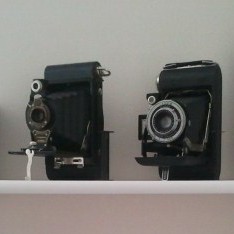
Nikon D40 is 6 mega-pixels APS-C sensor DSLR introduced in late 2006. It is the first “miniaturized” DSLR body from Nikon. The “miniaturization” include omission of the top LCD display, the use of penta-mirror instead of penta-prism for the viewfinder, a smaller battery, and most distinctively, the removal of the in-body screw-driver AF motor. The last change makes the D40 unable to autofocus with the older AF and AF-D lenses though an in-viewfinder focusing aid is still provided by the camera’s electronic rangefinder. I believe Nikon removed the in-body AF motor because they think most D40 users are beginner photographers and/or first-time DSLR buyers who would probably be using their new line of AF-S DX lenses rather than old AF lenese from the film-era. This is of course bad news for those Nikon users who are switching from film to digital because the D40, despite all the simplifications mentioned above, is a very capable body with an affordable price tag.


So what makes this “little” DSLR so capable? First of all, it 6 mega-pixels sensor, though having a relatively lower resolution than its competitors at the time of introduction, has been well-proven for its quality from the earlier D50 and D70 (and possibly also the D100). Compared to the 10 mega-pixels sensor used in the D40x, D80, and the D200, which were all available at the same, it has a lower noise level due to its lesser pixel-density. It also gives the camera a base sensitivity of ISO200 which is a nice welcome for today’s slow kit zooms. Combined this 6 mega-pixels sensor with the camera’s special shutter mechanism gives the D40 a surprisingly fast sync-speed of 1/500 seconds. As for metering and exposure, beside a reliable 3D-color matrix meter for easy one-touch reading in difficult lighting situations, the camera also has a spot meter that covers a small enough area (2.5% according an online source) to enable one to use the zone system to calculate exposure. In fact, the spot meter is what I use 90% of the time and is an indispensable feature of this camera. Regarding information display and image review, though the top LCD is omitted, the D40 has a comparatively large 2.5″ LCD pixels which has a resolution about 75% higher than the 2″ ones used in the D50 and D70. Even after almost 10 years, this screen is still adequately large and sharp for such a compact body.

Unlike the higher models (D70, D80, etc.), built-in flash of the D40 cannot be used as a master control for the the Nikon Creative Lighting System (CLS). In other words, it cannot trigger a slave-mode SB-600/SB-700/SB-800/SB-900/SB-910. To use the built-in flash as a master trigger, the flash would need to be fired in manual-power mode (possibly a unique feature to Nikon DSLRs, please kindly correct me if I am wrong). With the TTL pre-flash gone in this mode, the flash can now be used to trigger most Nikon flashes mounted on a SU-4 trigger or a pro-series one with a built-in SU-4 mode like the SB-800. Most importantly, this also enable the built-in flash to trigger studio strobes with optical slaves. When it is used as a master trigger, the power of the built-in flash can either be set to act as a fill or simply to the minimum power so that the light emitted will be just strong enough to trigger the slave but too weak to affect the subject.
So what place does an old 6 mega-pixels DSLR have in today’s “resolution-hungry” world? First, the D40 is a great vacation camera given its weight and compactness. Moreover, lower resolution means faster post-processing on a relatively slower travel computer (e.g. netbook, tablet-pc, …). This would be a great convenience for people (like me) who like to post travel photos at the end of the day inside a hotel room. Below is two photos from my last summer vacations, taken with the D40 and its kit lens, the AF-S 18-55mm f3.5-5.6 II:


Also, the spot meter equipped D40 is great “light-meter and polaroid back” combo for shooting large format. This is especially true because its older sensor has a narrower dynamic range which resembles more to traditional film emulsions. Also, it adds almost no weight to one who is already carrying a 4×5 camera and a heavy-duty tripod. Finally, who says 6 mega-pixels is low resolution and limited to making 8×10″ prints? Below are two of my exhibited images, taken with the D40 and a Tamron AF 28-200mm f3.8-5.6 lens at ISO400, resampled and resized to 12×18″:


Status: In Collection

